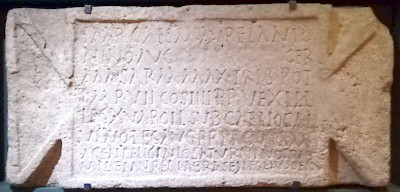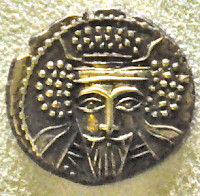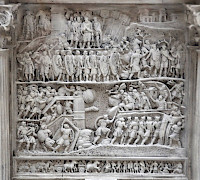Vologases V
Vologases V: Arsacid king of the Parthian Empire (r.191-208).

In the first half of the second century, the Parthian Empire had been divided, but king Vologases IV had reunited the two parts and had gained control in parts that had become independent (e.g., Characene). An attempt to appoint Pacorus as pro-Parthian king in Armenia (where the Romans traditionally appointed the kings) had resulted in a disaster, with the Roman armies occupying Armenia, appointing a pro-Roman king Sohaemus (163/164), and invading the Parthian Empire, even sacking the capital Ctesiphon (164), but Vologases had survived.
In 180, he managed to make his son, Vologases V, king of Armenia. The young man managed to cooperate with the Romans, who had a garrison in Vagharshapat, close to his capital Artaxata.
In 191, Vologases IV died and Vologases V became king of the Parthian Empire. (The new king of Armenia was a son of Vologases V, Khusrau.) The new but experienced ruler of Parthia appears to have overcome Osroes II, a rebel in Media, quickly: his coinage, based in Ecbatana, comes to an end almost immediately.
The year 193 marked a deep crisis in the Roman Empire. The emperor Commodus had been murdered in 192, his successor Pertinax had been killed by his own soldiers, who had sold the throne to Didius Julianus. In the north, Septimius Severus wanted to avenge Pertinax, and he allied himself to Clodius Albinus in the west; in the east, the governor of Syria, Pescennius Niger, accepted the purple. He was recognized by the eastern provinces and by Vologases V.

As it turned out, Vologases had backed the wrong horse: it was Septimius Severus who won the Roman civil war (194). Pescennius Niger tried to escape to Parthia, but was captured and killed. Now, there was a casus belli between the Roman and Parthian empires. Even worse, Severus needed a foreign victory to show that he had not merely selfishly won a civil war but was focused on the interest of the Roman state.
It seems that Vologases anticipated the war by moving to Nisibis, the place where earlier Parthian kings had built their HQs during Roman wars (e.g., Vologases I). Nisibis, however, sided with Rome, and Severus liberated the besieged city in the summer of 195. Returning to the west, he accepted the surrender of king Abgar VIII of Edessa. The towns were included in a new Roman province, Mesopotamia.

That old buffer states were incorporated in the Roman Empire, must have been unacceptable to Vologases and there must have been all kinds of tensions between Rome and Parthia. A new war broke out in 197 and Severus captured the twin cities of Seleucia and Ctesiphon. On his return, the Roman emperor tried to capture Hatra, but the city held out against the legions and proved that the Parthian Empire had been defeated but not conquered.
When Vologases V died in 208, he was succeeded by his son Vologases VI, who would be the uncontested ruler until another Roman intervention, in 216, by the emperor Caracalla. Although the Parthians survived this crisis, another son of Vologases V, Artabanus IV, had revolted and the Parthian Empire did not survive this new conflict.
Note
The chronology of the Arsacid kings of the Parthian Empire is less well-understood than, for example, the sequence of Seleucid and Ptolemaic kings or the emperors of Rome. This information is based on the researches by G.R.F. Assar, as published in "Iran under the Arsakids, 247 BC – AD 224/227" in: Numismatic Art of Persia (2011).